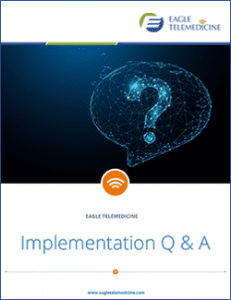Now it’s time to launch your telehealth coverage. This is when all the planning, testing and training pay-off. In the last post, we discussed the Mock-Go-Live, which is the real-time practice session that put everything into perspective. In this post, we move to the program Go-Live.
The program implementation process is complete. The Mock Go-Lives went off without a hitch and there were lots of good questions and interaction between the nurses and physicians on the ground and the Eagle telemedicine providers.
Nurses were able to simulate telemedicine consultations with the Eagle team and work with the technology, including the telemedicine cart and secured texting platform. In addition, the workflow was tested time and time again. Last-minute refinements were made with the team. Baseline metrics have been established and are ready to be tracked. Now it’s showtime for your telehealth coverage!
When to schedule the telehealth coverage Go-Live?
Key factors to consider when scheduling the program Go-Live:
• Depending on the program, Go-Lives should typically be scheduled at the first of the week to ensure the most robust staffing is available.
• Avoid Go-Live dates around any major holidays or EMR upgrades.
Once the Go-Live date is set, Eagle’s operations team reviews the key reference sheet with all the providers and leads a final onboarding session with all of them. This enables any last-minute questions to surface and ensures everyone understands the specifics of the individual hospital, including services offered, sign-out, transfers, etc.
As the program begins, our telemedicine providers use our proprietary operating system, ETHOS (Eagle Telehealth Operating System), to navigate between hospital sites and access valuable information from the key reference sheet. For the first week after a program starts, Eagle’s operations team will set up daily “huddles” with the telemedicine providers and the hospital nurses and physicians at the end of each shift to review program performance, answer questions, etc. This session is invaluable and provides real-time feedback as to how everything is going and whether any changes should be made.
One of our keys to success is to communicate extensively not only with the patients and their families but also with our hospital partner nurses and providers as well as administrative and operational staff. There is no such thing as over-communication in these projects! Collectively, this type of transparency allows for real-time feedback, helps identify the positives and enables the team to immediately focus on opportunities for improvement. The feedback keeps everyone on the same path, driving toward the strategic goals set for the program and ensuring the expected ROI is delivered.
Get the Answers to Your Questions About Real-Time Telemedicine

Our Eagle Eye™ process of managing telehealth coverage programs after the Go-Live creates long-term, satisfied relationships with our hospital partners.
Tenets of this program include:
1. Eagle Telemedicine providers have direct availability to members of the operations team, including IT support 24/7. That means when issues arise, they’ll get solved. Eagle Telemedicine providers have access to the ETHOS trouble-ticket system 24/7, which allows them to enter urgent operational or IT issues, or have issues evaluated that are non-emergent.
2. The workflow with the hospital partners always provides access to an Eagle administrator on-call 24/7.
3. Metrics are tracked and reported monthly, with exchange of information between the hospital partner and Eagle.
4. Monthly performance reports are developed for each program, with metrics that track baseline performance for each program.
5. Monthly program reviews are set immediately after program Go-Lives to review Eagle’s five “Ps” to success:
- People
• Individual excellence
• Individual challenges - Performance
• Select clinical case review as needed
• Productivity
• Metrics - Partnership
• Client priorities
• New initiatives - Platform
• New opportunities/growth - Perspective
• Global assessment (Are we meeting current needs? What lies ahead?)
• Next steps and follow-ups as needed
These reviews are invaluable and provide a key touchpoint at the end of each month to assess the current health of the program.
As the telemedicine program matures, Eagle’s operations department meets with both marketing teams to develop case studies along with ways to highlight success and to further educate internal and external constituents about the program.
Our hospital partner tenure is long, with some clients having programs with us for over a decade. Healthcare is ever-evolving, and Eagle will continue to lead the way when it comes to technology-enabled inpatient care.
Also, feel free to review or catch up on:
- Part 1 of the series, Efficient Use of Telemedicine Starts with a Kick-off Call, talks about identifying the team and tasks during your first implementation call.
- Part 2 of this series, Implementing Real-Time Telemedicine Begins, we discuss what the weekly calls entail and how they lead to successful implementations.
- Part 3 of this blog series, Telemed Services Mock Go-Live, discusses how to train and test your program before launch.






